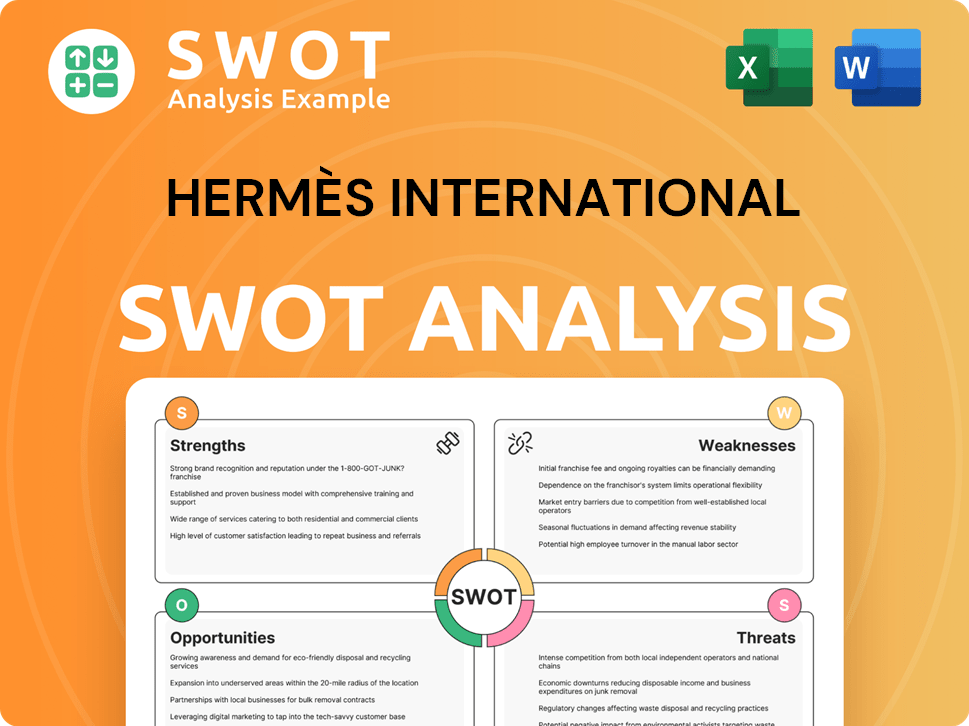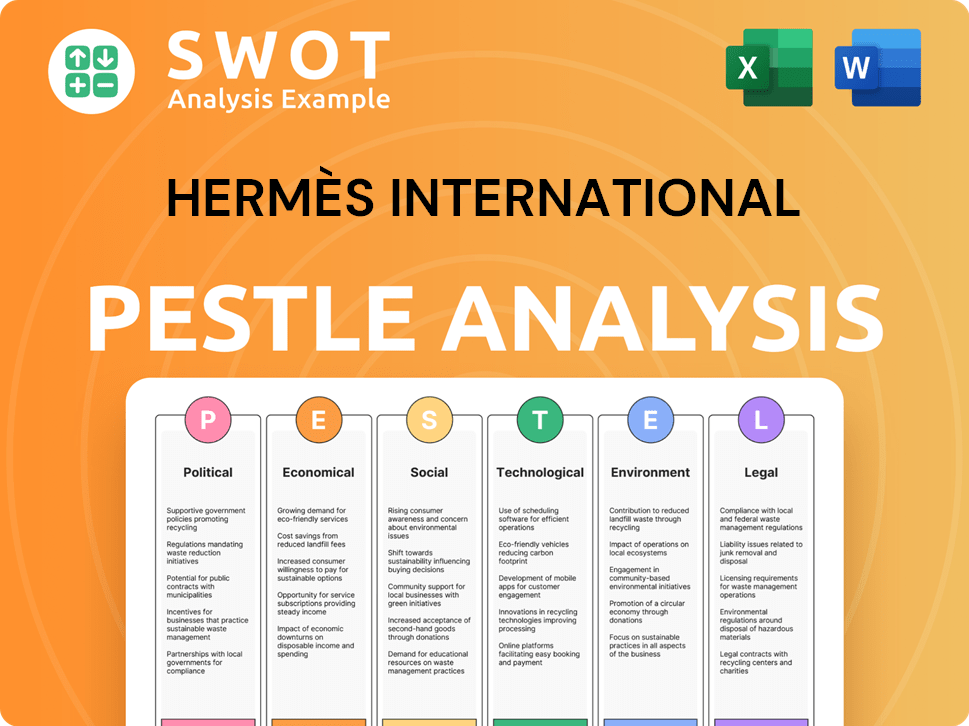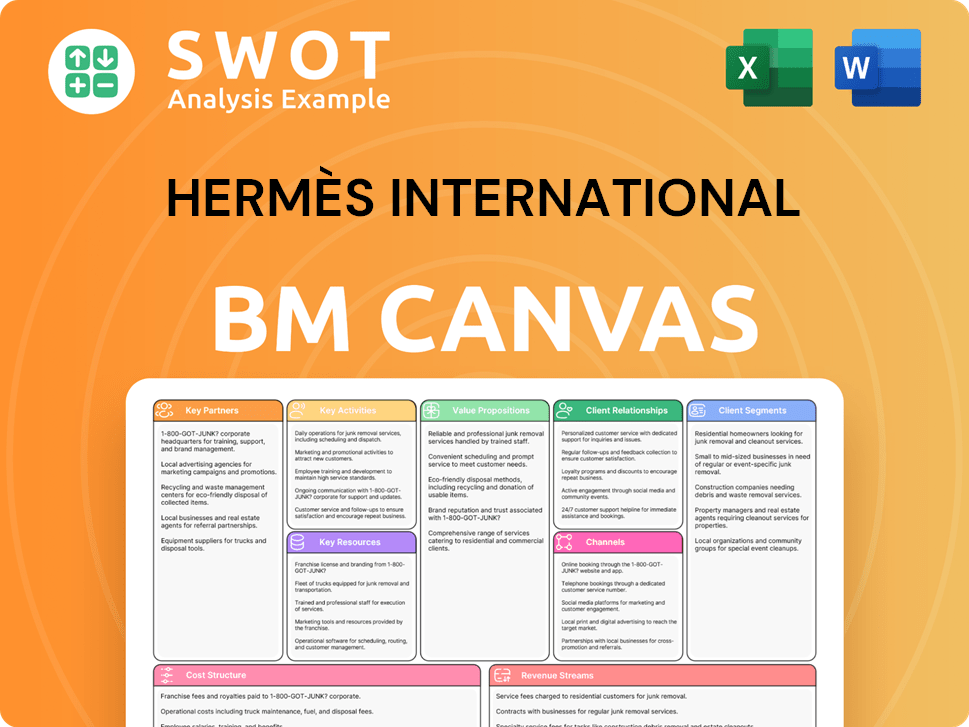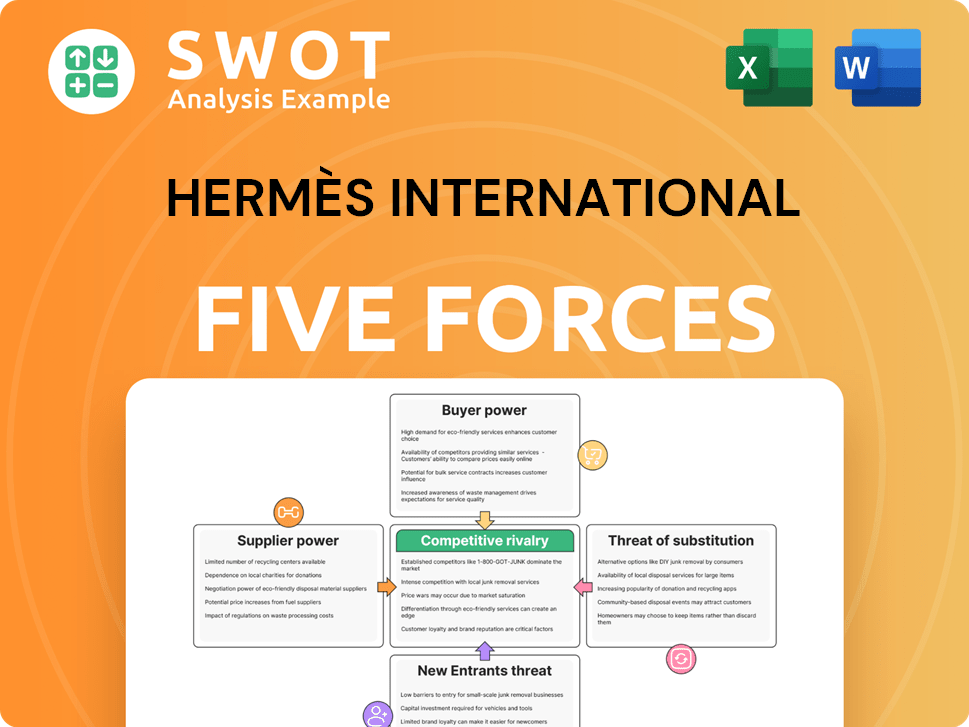Hermès International Bundle
How did a harness workshop become a global luxury icon?
Journey back in time to 1837 Paris, where Thierry Hermès laid the foundation for a brand synonymous with luxury. From crafting exquisite equestrian gear for European nobility, the Hermès International SWOT Analysis reveals how this commitment to quality propelled the company. Discover how Hermès evolved, transforming from a specialized workshop into a global powerhouse of French fashion.

The Hermès history is a captivating narrative of meticulous craftsmanship, strategic innovation, and unwavering dedication to quality. Explore the Hermès company's remarkable journey, tracing its roots from its equestrian heritage to its expansion into luxury goods. Uncover the secrets behind the Hermès brand's enduring appeal and its ability to thrive in the competitive high-end fashion market.
What is the Hermès International Founding Story?
The story of the Hermès history began in 1837, marking the inception of a brand that would become synonymous with luxury and craftsmanship. This Hermès company, originating in Paris, France, has a rich heritage rooted in equestrian pursuits and a commitment to unparalleled quality, establishing itself as a cornerstone in the world of high-end fashion.
Thierry Hermès, the founder, laid the foundation for what would evolve into a global icon. His dedication to excellence and meticulous craftsmanship set the stage for the brand's enduring legacy. From its humble beginnings catering to the elite, Hermès has transformed into a symbol of refined taste and luxury, captivating a global audience.
Thierry Hermès established the company on June 10, 1837, in Paris, France. He initially focused on creating high-quality harnesses and bridles for the carriage trade, serving the European nobility.
- Thierry Hermès, born in Germany, moved to France and apprenticed as a harness-maker.
- The initial business model emphasized meticulous craftsmanship, particularly the unique hand-stitched saddle stitch.
- Hermès gained recognition, winning awards at the Paris World Fair in 1855 and 1867.
- The company's name, Hermès, directly reflects its founder.
Hermès International SWOT Analysis
- Complete SWOT Breakdown
- Fully Customizable
- Editable in Excel & Word
- Professional Formatting
- Investor-Ready Format

What Drove the Early Growth of Hermès International?
The early growth and expansion of the Hermès company significantly shaped its trajectory in the luxury goods market. This period witnessed the relocation of its workshop and the diversification of its product lines, laying the foundation for its global presence. Key strategic decisions, such as the adoption of the zipper and expansion into various product categories, were critical to its early success. The company's commitment to craftsmanship and exclusivity further solidified its position in high-end fashion.
In 1880, Charles-Émile Hermès moved the workshop to 24 Rue du Faubourg Saint-Honoré in Paris, which remains the global headquarters. Between 1880 and 1900, the company began selling saddlery and introduced its products in retail stores. This marked a strategic shift towards broader market accessibility while maintaining a focus on quality.
Under Émile-Maurice Hermès in the early 20th century, the company expanded beyond harnesses. They introduced travel and sport-related leather goods, ready-to-wear clothing, watches, and gloves. Securing exclusive rights to use the zipper in leather goods and clothing in the 1920s was a pivotal innovation.
After World War II, Hermès continued its geographical and product category expansion. This included clothing, accessories, and perfumes, broadening its appeal in the luxury market. The company's growth strategy emphasized exquisite craftsmanship and an aura of exclusivity.
Hermès has embraced an integrated and omnichannel distribution network, with a strong focus on exclusive stores. In 2023, real estate investments for new stores were the largest single investment category at €392 million. This underscores their commitment to physical retail expansion and brand enhancement.
Hermès International PESTLE Analysis
- Covers All 6 PESTLE Categories
- No Research Needed – Save Hours of Work
- Built by Experts, Trusted by Consultants
- Instant Download, Ready to Use
- 100% Editable, Fully Customizable

What are the key Milestones in Hermès International history?
The Hermès history is marked by significant milestones that have shaped it into a leading luxury goods brand. From its origins as a harness workshop to its global presence today, the Hermès company has consistently demonstrated a commitment to craftsmanship and quality. The Hermès brand has a rich history, full of key moments that have defined its identity.
| Year | Milestone |
|---|---|
| 1837 | Thierry Hermès founded a harness workshop in Paris, initially catering to the needs of noblemen. |
| 1937 | The introduction of the 'Carré' silk scarf marked a significant expansion into French fashion. |
| 1930s | The Kelly bag, originally designed in the 1930s, gained prominence and was later named after Grace Kelly. |
| 1984 | The Birkin bag, inspired by actress Jane Birkin, was launched, becoming one of the most coveted luxury handbags. |
| 2024 | Hermès maintained double-digit growth across categories, defying trends impacted by China's slow recovery and reduced aspirational spending. |
Hermès has consistently innovated, expanding its product lines while maintaining its core values. The brand's ability to blend heritage with contemporary design has been key to its enduring appeal. This is evident in the evolution of the brand's products and its approach to retail.
The 'Carré' silk scarf, introduced in 1937, quickly became an iconic product, showcasing the brand's artistic talent and craftsmanship. These scarves are renowned for their intricate designs and high-quality silk, representing a significant innovation in high-end fashion.
The Kelly and Birkin bags, introduced in the 20th century, are symbols of luxury and exclusivity. These bags are handcrafted by skilled artisans, taking hundreds of hours to complete, highlighting Hermès's dedication to quality and detail.
Hermès has maintained its connection to its equestrian heritage, reflected in its leather goods and design motifs. The brand's early focus on harnesses and saddles has influenced its product lines, ensuring a blend of functionality and elegance.
Hermès has adopted a strategy of controlled distribution and scarcity to maintain its exclusive image. The waiting lists for its most emblematic items, like the Birkin and Kelly bags, are a deliberate strategy to enhance desirability and brand value.
Over time, Hermès has diversified its product lines, expanding into ready-to-wear, perfumes, and home goods. This diversification has allowed the brand to cater to a broader customer base while remaining true to its core values of quality and craftsmanship.
Hermès has embraced digital platforms to enhance its customer experience and expand its reach. The brand has invested in e-commerce and social media to connect with customers and showcase its products.
Despite its success, Hermès has faced challenges in maintaining its brand image and navigating market dynamics. The luxury market is competitive, and the brand must continually adapt to changing consumer preferences and economic conditions. The company has to balance growth with preserving its exclusive image.
Hermès has had to navigate market downturns and economic fluctuations. The brand's resilience has been tested during periods of economic uncertainty, requiring strategic adjustments to maintain sales and brand value.
The luxury market is highly competitive, with numerous brands vying for consumer attention. Hermès faces competition from both established luxury houses and emerging brands, requiring continuous innovation and brand differentiation.
Balancing growth with preserving exclusivity is a key challenge for Hermès. The brand must carefully manage its distribution and product availability to maintain its prestige and desirability.
Currency fluctuations can impact Hermès's financial performance, particularly given its global presence. The brand must manage currency risks to maintain profitability and competitiveness in different markets.
Ensuring a reliable supply chain is essential for Hermès, given its reliance on craftsmanship and high-quality materials. Managing the supply chain effectively is crucial for meeting customer demand and maintaining product quality.
Adapting to changing consumer preferences and trends is vital for Hermès. The brand must stay relevant and appealing to its target audience by innovating its product offerings and marketing strategies.
Hermès International Business Model Canvas
- Complete 9-Block Business Model Canvas
- Effortlessly Communicate Your Business Strategy
- Investor-Ready BMC Format
- 100% Editable and Customizable
- Clear and Structured Layout

What is the Timeline of Key Events for Hermès International?
The Hermès history is a tale of enduring craftsmanship and luxury. Founded in 1837 by Thierry Hermès as a harness workshop in Paris, the company evolved over the decades, marking significant milestones in the world of luxury goods. From its early focus on equestrian supplies to its expansion into French fashion and high-end fashion accessories, the Hermès company has consistently represented quality and exclusivity.
| Year | Key Event |
|---|---|
| 1837 | Thierry Hermès founded a harness workshop in Paris, marking the beginning of the Hermès brand. |
| 1880 | The company moved to 24 Rue du Faubourg Saint-Honoré, a location that remains significant today. |
| Early 1900s | Émile-Maurice Hermès expanded the product line to include luggage and handbags, and secured exclusive rights to the zipper. |
| 1937 | The introduction of the iconic Hermès silk scarf, the 'Carré,' expanded the brand's offerings. |
| 1950s | The company introduced the Duc-carriage-with-horse logo and its signature orange boxes, solidifying its brand identity. |
| 1978 | Jean-Louis Dumas became head of the company, transforming it into a global luxury brand. |
| 1984 | The highly sought-after Birkin bag was introduced, becoming a symbol of luxury. |
| 2011 | The Hermès family pooled shares to prevent a takeover, ensuring family control. |
| 2024 | Hermès reported consolidated revenue of €15.2 billion, a 15% increase at constant exchange rates compared to 2023, with recurring operating income reaching €6.2 billion. |
| Q1 2025 | Consolidated revenue reached €4.1 billion, up 9% at current exchange rates and 7% at constant exchange rates. |
In 2024, Hermès achieved a consolidated revenue of €15.2 billion, reflecting a 15% increase at constant exchange rates. The company's recurring operating income reached €6.2 billion. For Q1 2025, revenue reached €4.1 billion, up 9% at current exchange rates. This financial strength supports the company's expansion plans and commitment to employee benefits.
Hermès plans to open new leather goods workshops in L'Isle-d'Espagnac (Charente) in 2025, Loupes (Gironde) in 2026, and Charleville-Mézières (Ardennes) in 2027. The company's strategy, themed 'Drawn to Craft,' emphasizes reinforcing its artisanal roots and expanding production capacity. These expansions are crucial for meeting growing demand and maintaining its high standards.
Sustainability is a key focus for Hermès, with updated climate strategies and adherence to Science-Based Targets (SBTi) for emissions reduction. This commitment ensures the brand's long-term viability and aligns with the growing consumer demand for ethical practices. These efforts are essential for maintaining its reputation.
Analysts forecast Hermès International to grow earnings and revenue by 9.7% and 8.9% per annum, respectively. The stock price is projected to potentially reach an average of $3,819.26 in 2025, a 38.29% rise from recent prices. This positive outlook reflects the company's strong market position and growth potential.
Hermès International Porter's Five Forces Analysis
- Covers All 5 Competitive Forces in Detail
- Structured for Consultants, Students, and Founders
- 100% Editable in Microsoft Word & Excel
- Instant Digital Download – Use Immediately
- Compatible with Mac & PC – Fully Unlocked

Related Blogs
- What is Competitive Landscape of Hermès International Company?
- What is Growth Strategy and Future Prospects of Hermès International Company?
- How Does Hermès International Company Work?
- What is Sales and Marketing Strategy of Hermès International Company?
- What is Brief History of Hermès International Company?
- Who Owns Hermès International Company?
- What is Customer Demographics and Target Market of Hermès International Company?
Disclaimer
All information, articles, and product details provided on this website are for general informational and educational purposes only. We do not claim any ownership over, nor do we intend to infringe upon, any trademarks, copyrights, logos, brand names, or other intellectual property mentioned or depicted on this site. Such intellectual property remains the property of its respective owners, and any references here are made solely for identification or informational purposes, without implying any affiliation, endorsement, or partnership.
We make no representations or warranties, express or implied, regarding the accuracy, completeness, or suitability of any content or products presented. Nothing on this website should be construed as legal, tax, investment, financial, medical, or other professional advice. In addition, no part of this site—including articles or product references—constitutes a solicitation, recommendation, endorsement, advertisement, or offer to buy or sell any securities, franchises, or other financial instruments, particularly in jurisdictions where such activity would be unlawful.
All content is of a general nature and may not address the specific circumstances of any individual or entity. It is not a substitute for professional advice or services. Any actions you take based on the information provided here are strictly at your own risk. You accept full responsibility for any decisions or outcomes arising from your use of this website and agree to release us from any liability in connection with your use of, or reliance upon, the content or products found herein.